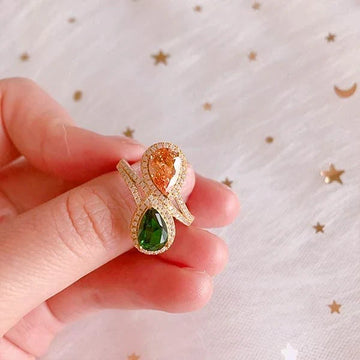Crystals, in their myriad shapes and sizes, are not just admired for their clarity and brilliance, but also for the stunning array of colors they display. From the deep purple of amethyst to the vibrant green of emerald, the rainbow of hues found in crystals is a testament to the fascinating interplay of chemistry and physics within the Earth. Let’s delve into the alchemy of color and explore the secrets of how crystals acquire their captivating shades.
I. Trace Elements: The Key to Many Crystal Colors
- The Power of Impurities: In many cases, the color of a crystal is not due to its primary chemical composition but rather to trace amounts of impurities present within its structure. These impurities, often metallic elements, act as chromophores, which are substances that absorb certain wavelengths of light and reflect others.
-
Examples:
- Amethyst (Purple): The purple color of amethyst is due to trace amounts of iron (Fe) impurities that have been irradiated by natural radiation within the Earth.
- Rose Quartz (Pink): The pink hue of rose quartz is believed to be caused by trace amounts of titanium, iron, or manganese.
- Citrine (Yellow/Orange): The yellow to orange colors of citrine are typically due to iron impurities. Natural citrine is rarer than heat-treated amethyst, which is often used to create citrine.
- Emerald (Green): The vibrant green color of emerald is caused by trace amounts of chromium and sometimes vanadium.
Double Stone Pear Shape Ring
II. Color Centers: Defects in the Crystal Lattice
- What are Color Centers? Color centers are defects or imperfections in the crystal lattice that can absorb certain wavelengths of light, resulting in color. These defects can be caused by missing atoms, displaced atoms, or the presence of foreign atoms in unusual locations within the crystal structure.
- Irradiation’s Role: In some cases, irradiation can create or modify color centers, altering the crystal’s color.
-
Examples:
- Smoky Quartz (Brown/Gray): Smoky quartz gets its color from natural irradiation, which causes defects in the crystal lattice.
- Blue Halite (Blue Salt): Blue halite’s color is due to structural defects created by ionizing radiation.
III. Band Theory: Electron Transitions and Light Absorption
- Electrons and Energy Levels: Electrons in atoms exist at specific energy levels. When a crystal is exposed to light, electrons can absorb energy and jump to higher energy levels.
- Selective Absorption: The specific wavelengths of light that are absorbed depend on the energy differences between the electron energy levels. When certain wavelengths are absorbed, the remaining wavelengths are reflected, resulting in the crystal’s perceived color.
- Transition Metals: Transition metals, with their partially filled d-orbitals, are particularly prone to absorbing certain wavelengths of light, leading to a wide range of colors in crystals that contain these elements.
Double Stone Pear Shape Ring
IV. The Influence of Chemical Bonding
- Charge Transfer: In some crystals, color can arise from charge transfer between different ions within the crystal lattice. This occurs when an electron moves from one ion to another, absorbing energy in the process.
- Ligand Field Theory: This theory explains how the arrangement of atoms around a central metal ion (the ligand field) affects the energy levels of the metal ion’s electrons, influencing the wavelengths of light that are absorbed and the resulting color.
V. Beyond Simple Impurities: Complex Interactions
- Synergistic Effects: The color of a crystal can sometimes be influenced by the interaction of multiple factors, such as the presence of several different trace elements or the combination of trace elements and color centers.
- Metamorphism and Hydrothermal Processes: The conditions under which a crystal forms (temperature, pressure, chemical environment) can also play a significant role in its color. Metamorphic processes and hydrothermal activity can alter the crystal’s composition and structure, leading to changes in its color.
Understanding the complex interplay of factors that contribute to crystal color opens a window into the fascinating world of mineralogy and the intricate processes that shape our planet. Next time you admire the vibrant hue of a crystal, remember that it’s not just a pretty color; it’s a reflection of the unique chemical and physical history of that crystal.







